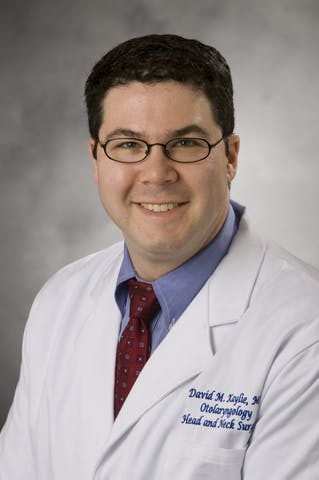Transmastoid Repair of Superior Semicircular Canal Dehiscence
Main Text
Semicircular canal dehiscence is associated with conductive hearing loss, autophony, and pressure/sound induced vertigo. Patients who are symptomatic may elect to undergo surgical intervention. The transmastoid approach affords the opportunity for an outpatient procedure to expose and plug the canal around the defect.
Patients with superior semicircular canal dehiscence (SSCD) can present with a variety of symptoms. Several symptoms overlap with other otologic and vascular syndromes, and should be distinguished from SSCD by a detailed history and physical exam. Since the first description of its manifestations by Minor,1 diagnostic methods and treatments have evolved significantly.
Symptoms often include autophony, aural pressure, vestibular symptoms induced by noise or pressure changes, pulsatile tinnitus, and hearing loss.
On physical exam, the patient’s tympanic membrane and middle ear space may appear normal. Upon the induction of loud sounds or pressure changes (pneumatic otoscopy), patients may experience a vertical and torsional nystagmus aligned with the superior canal.2 In cases with conductive hearing loss, a tuning fork will demonstrate bone conduction greater than air conduction in the affected ear, and lateralization to the affected ear on Weber exam.
Additional studies are critical in the diagnosis of SSCD. Autophony is present in patients with patulous eustachian tube, and numerous middle ear conditions cause conductive hearing loss. A high resolution computed tomography (CT) scan of the temporal bone should be obtained to determine the amount of bone overlying the superior canal. When ordering these tests, it is important to specify the orientation of the reconstructions in the plane of the canal as well as perpendicular to that plane. Vestibular evoked myogenic potentials (VEMP) can also aid in the diagnosis. Thresholds for eliciting a response in cervical VEMP testing are lower in the affected ear compared to a normal ear.
An audiogram may demonstrate a conductive hearing loss. An important distinction is the presence of suprathreshold bone conduction lines.
Diagnosis of SSCD may be an incidental finding of a CT obtained for an unrelated purpose. Patients may be asymptomatic or have any of the previously mentioned symptoms in combination. For patients who are asymptomatic or not bothered by symptoms, observation may be appropriate. For those with more troublesome or debilitating symptoms, several surgical options exist.
If the primary symptoms are pressure-induced (Tullio phenomenon), placement of a tympanostomy tube may be useful. For others, canal resurfacing via a middle fossa craniotomy or plugging via the same approach or by mastoidectomy may be required.
The patient in this case was significantly bothered by her autophony given the necessity for her to talk frequently at work. She also had dizziness that was induced by straining (Valsalva against a closed glottis). When the diagnosis was confirmed, options of observation, vestibular therapy, and surgical intervention were discussed. The middle cranial fossa approach and transmastoid approach were discussed with the advantages and disadvantages of each. Given the outpatient nature of the transmastoid procedure, and the significant detriment to quality of life by her symptoms, the patient elected to proceed.
In older patients, a middle fossa craniotomy with retraction of the temporal lobe may have greater risk than in younger patients. Additionally, patients undergoing middle fossa craniotomy often require a lumbar drain and inpatient admission. Conversely, the transmastoid approach affords the opportunity for an outpatient procedure. Patients should be counseled regarding the specific risks of the procedure, which include facial nerve injury and transient or permanent hearing loss.
General anesthesia, endotracheal intubation, and avoidance of any long-acting muscle relaxants due to the need for facial nerve monitoring throughout the procedure.
The patient is placed supine with the head turned away from the operative side. The arms are tucked, and the blood pressure cuff should be placed on the arm opposite of the surgical side. The bed is rotated 180 degrees away from anesthesia.
Bi-channel facial nerve monitoring is utilized.
Standard Betadine scrub and solution is used.
A standard postauricular incision is performed approximately 5–10 mm posterior to the postauricular sulcus. After dividing the skin and subcutaneous tissue, the temporoparietal fascia is encountered. Deep to this, an avascular plane superficial to the temporalis fascia is opened and carried to the level of the external auditory canal. Superiorly, the dissection is opened more anteriorly over the root of the zygoma. Temporalis fascia may be harvested, pressed, and set aside to dry. A periosteal incision is then made along the temporal line. Either a “T-shaped” or “7-shaped” incision is made by bisecting the mastoid tip. The periosteum is elevated superiorly, posteriorly, and then anteriorly to expose the spine of Henle. Next, a mastoidectomy should be performed, delineated by the tegmen superiorly, the sigmoid sinus posteriorly, and the ear canal anteriorly. During the drilling, the surgeon may collect the bone dust to use as pâté for occluding the canal later in the procedure. When the antrum is opened, the lateral semicircular canal and the short process of the incus should be identified. Next, the facial nerve can be exposed distal to the second genu and along the descending segment. It does not need to be decompressed or exposed to the stylomastoid foramen. With the tegmen and the lateral semicircular canal exposed, the superior canal at the common crus is located. It is traced superiorly and anteriorly to uncover its entire course. It is important to understand the anatomy of the superior canal relative to the other semicircular canals and the petrous ridge. “Blue-lining” of the canal is then performed. The lateral surface of the canal is carefully thinned until the endosteum is exposed. It is critical to perform this step carefully, as violation of the membranous labyrinth can result in profound sensorineural hearing loss. Some surgeons will blue line small areas anteriorly (just proximal to the ampullated end) and posteriorly (just distal to the common crus) for plugging. Others will expose the entire canal, thus ensuring that the occlusion occurs around the defect in the tegmen. Next, bone pâté is carefully packed anterior and posterior to the defect (if limited exposure) or along the course of the canal. Bone wax can be gently pressed over these areas using a moistened cottonoid. Alternatively, previously harvested fascia can be cut and tucked over the bone pâté. A small piece of Gelfoam can then be laid over the canal.
The periosteum is closed in interrupted fashion using 3-0 Vicryl suture. The first stitch is typically thrown to approximate the Palva flap with the most posterosuperior aspect of the periosteal incision. After closing the periosteum, the deep dermal layer is also closed in interrupted fashion using a 4-0 Monocryl suture.
The wound is dressed with Steri-Strips after applying benzoin or Mastisol, followed by either a Glasscock dressing or a mastoid pressure dressing.
Patients are advised of the following
- Keep the head of the bed elevated to 30 degrees for 48–72 hours after surgery.
- No nose blowing.
- Do not try to stifle coughing or sneezing, do so with the mouth open.
- Do not shower for 48 hours. At this point, the patient may shower but should only let soap and water run over the incision, without scrubbing. It should be dried by gently patting the area.
- The Steri-Strips may begin to peel and fall off, but they should be left in place until removed by the surgeon.
- Postoperative pain is managed with ibuprofen, 600 mg tablets every 6 hours as needed, provided that the patient does not have any adverse reactions or history of gastric ulcer.
- If narcotics are provided, patients should take a stool softener to avoid any straining during bowel movements.
- Do not lift greater than 10–15 pounds for 2 weeks after surgery.
Standard postoperative instructions regarding fevers, pain management, and warning signs are provided with phone numbers to the office and hospital to reach a physician at any time.
Follow up for a wound check should occur 1–2 weeks following surgery.
An audiogram is performed 3 months following surgery.
- Standard microscopic ear tray
- Drill system with cutting and diamond burrs
- Facial nerve monitoring system
Author C. Scott Brown also works as editor of the Otolaryngology section of the Journal of Medical Insight.
The patient referred to in this video article has given their informed consent to be filmed and is aware that information and images will be published online.
References
- Minor LB. Superior canal dehiscence syndrome. Am J Otol. 2000;21(1):9-19.
- Cremer PD, Minor LB, Carey JP, Della Santina CC. Eye movements in patients with superior canal dehiscence syndrome align with the abnormal canal. Neurology. 2000;55(12):1833-41. doi:10.1212/wnl.55.12.1833.
Cite this article
Brown CS, Kaylie DM. Transmastoid repair of superior semicircular canal dehiscence. J Med Insight. 2023;2023(248). doi:10.24296/jomi/248.


